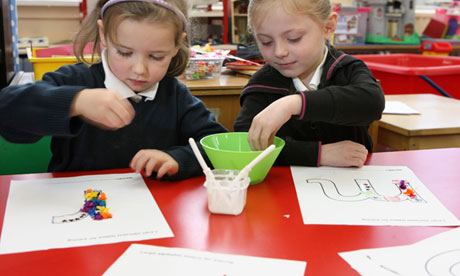10 creative ways to teach English that deliver outstanding results

Creative curriculum:
inspiring young imaginations using the arts is just one of the ways Anna
Warren teaches her pupils. Photograph: Tom Finnie
As a creative school, with a track record in fantastic
English results,
we are often asked what our specific approach is: how do we teach
through the arts yet manage to maintain such high expectations from all
our pupils? I'd like to share some of these approaches with you:
Immersion activities
How
can children access stories, poems and other texts if their minds and
imaginations not fully engaged? We have found that immersing children in
a range of creative activities before reading the text means that they
are fully prepared, and excited, about the reading journey ahead of
them. Through painting, music composition, a film project, in role drama
or sculpture, the kids have had a chance to share vocabulary, ideas and
concepts which gives their reading fresh meaning and purpose.
Clear purpose
What's
the point of reading and writing anything if you don't know why you're
doing it? We aim to provide children with a clear purpose to all
reading, and especially writing tasks. Whether it's an invitation to the
headteacher to attend a class assembly, an email to an author or an
article for a school newspaper, our children know why the quality of
their writing matters: because there will be a real audience for their
published work.
Professional publishing
One
effective way of valuing children's work as well as providing a real
incentive, is to plan for a range of ways to publish their writing.
Recent examples include a whole school bookmaking project. Following a
whole school Inset on bookbinding techniques, every class published
their own shared book; one example being an anthology of short spooky
stories composed by year 6. Their stories were mounted on handmade
paper, accompanied with each child's art work (lino cut style prints on
metallic paper) with a dramatic paper cut out front cover. The effort
the children put into their work was immense, and the results were
stunning as a result. The anthology has been enjoyed by parents and
other pupils and the children's pride in their work is clear to see.
Meaningful planning
Where possible, learning in
English is linked with subjects within the creative curriculum we follow: the
international primary curriculum (IPC). Well in advance of
teaching,
teachers collaborate and share their ideas for planning through a mind
mapping process. Meaningful, creative activities are planned for,
ensuring that all staff members know exactly what the children will be
learning and why.
Focused on strategies
The
teaching of reading is not easy. As children's fluency in reading
increases, it's hard to know what reading skills need to be taught, and
when. We ensure that specific reading strategies are modelled explicitly
to the class; this provides children with a holistic bank of skills to
draw upon. This could include scanning a text, making an inference,
predicting or creating a mental image. Our teachers use 'think aloud'
statements to model to the children how these skills are used, and how
they can help them become better readers. These strategies are then
shared as a class, and then assessed in follow up guided reading
activities.
Inspirational learning environment
Take
a trip to our school and you'll find classroom environments that
inspire adults and children alike. Not only is the children's work
displayed creatively, but there is a range of learning prompts to
inspire and support all pupils. We want to encourage our children to
discover new texts, genres and authors, so our reading areas are
inviting, well resourced and highly organised. Pupils can choose from an
exciting array of reading material: newspapers, classic texts,
reference books as well as the children's own published stories are just
some examples of what book corners might offer.
Drama to engage and inspire
The
use of drama is such a powerful tool. Taking the lead from our drama
specialist, all teaching staff use a range of techniques to promote the
exploration of characters, situations and historical events. This
process expands the pupils' imaginations, and provides them with the
ideas they need to give their writing that extra spark and flair.
Rigorous teaching of spelling and phonics
In
the infants, phonics is streamed, so all children can benefit from
tailored teaching, making maximum progress as a result. All phonics and
spelling activities are fun, multi sensory and as physical possible, the
aim being to meet all learning styles in the class. In the juniors, we
try to make homework lists as personalised to the child as possible to
ensure that the spelling patterns stick in a meaningful way.
Grammar concepts taught creatively
Grammar
cannot be taught as a stand alone activity. What's the point of that?
Children begin to understand grammar concepts, and start to apply them
in their own writing, when they start to read with a writer's mind.
Punctuation rules and techniques are drawn from shared texts; texts
which the children have already been immersed in and have a good
understanding of. Exploring these, and embedding them creatively is how
the learning takes place.
Peer and self assessment
What
child doesn't love marking somebody else's work? With a clear marking
key, success criteria and purpose in mind, children set about assessing
either their own, or a partner's piece of writing. Modelled through the
teacher's own formative marking, pupils know what the expectations are.
They are well trained in searching for successful examples of the
learning intention, articulating their responses to the work, checking
the writing matches any targets and giving constructive feedback. Seeing
the children learn from each other in this way is hugely positive; you
know you've done your job well.


Tidak ada komentar:
Posting Komentar